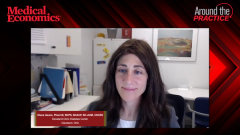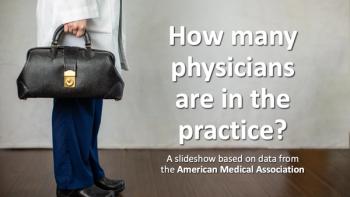
Clinical Insights for Primary Care Providers in Type 2 Diabetes and Cardiovascular Disease
A panel of experts provide clinical pearls for primary care providers who manage patients with diabetes and cardiovascular comorbidities.
Episodes in this series

Dhiren Patel, PharmD, CDE, BC-ADM, BCACP: I think you would all agree that many of you are embedded in specialty clinics. Overall, and the last numbers I looked at, and I’d probably bet that they’re still kind of there, I saw GLP [glucagon-like peptide] usage of around 7%, SGLT-2s [sodium-glucose cotransporter-2], 4%. Nonetheless they’re probably both less than 10%. What message do you have for those that are on the front lines, our primary care providers, as they think about the impact of some of these CV [cardiovascular] medications? But obviously we’re not conferring to our patients because they’re not, maybe they’re on an SU, maybe they’re on a DPP-4 [dipeptidyl peptidase 4] inhibitor. What would your message to that group of folks be? They’ve adopted DPP-4 maybe too well. Now we need them to adopt a different oral pill. Dr. Isaacs, maybe we’ll start with you. I know you get a lot of your referrals from that community.
Diana Isaacs, PharmD, BCPS, BCACP, BC-ADM, CDCES: Yeah, I’m glad you went to me because I have a message, yes. I would be avoiding therapeutic inertia. We see these guidelines and we see, oh, yeah, person has cardiovascular risk, we should be considering these agents. But a lot of the patients that come to me have had diabetes for so many years, they are already on some established regimen, sometimes it’s a basal insulin, it could be with a DPP-4 inhibitor, or they’re already on MDI. I always tell my students and my residents training with me, we must think big, right? If they are not on these agents, they’re not on an SGLT-2 inhibitor, they’re not on a GLP-1 agonist, even if they’re not on metformin, we have to ask why. Sometimes it was just something like they were in the hospital, and they just got rid of all these agents and decided to put them on MDI. Some people mistakenly think once someone is on insulin, they cannot continue their other agents. There’s all these people out there that could be benefitting from these agents, so we really need to think big, don’t just continue. Yes, while it may seem like, oh, it is easier to just increase the insulin by 2 units, no. We need to be thinking about the benefits of these agents.
Dhiren Patel, PharmD, CDE, BC-ADM, BCACP: Absolutely. Dr. Busch?
Robert Busch, MD: If they want to get the hugs, they should initiate it. Remember, these drugs also induce weight loss. You have someone who hasn’t lost weight for many years and put on an SGLT-2 and/or GLP-1, they will lose weight and they don’t get hypoglycemic on it, and if they’re on insulin or a sulf, you can taper it down, maybe come off of it down the line. I think that’s what alienates some of our cardiologists. If the patient is on an insulin, they don’t want to go into the insulin titration business, they leave it to someone else. They might be a little gun shy to start those. But amongst our cardiologists, if you’re not on insulin or sulf or a drug that causes hypoglycemia, feel comfortable to use these classes because hypoglycemia is a non-issue. The patient doesn’t have to monitor their sugar in those cases. But not only the A1C lowering, but these other benefits plus the weight loss.
Just to cap this off, if I told my chief of endocrine years ago that you had a drug that could lower weight, blood pressure, and A1C without hypoglycemia, prevent heart failure, pre-heart failure, and treat kidney disease in diabetics and nondiabetics, he would fire me for hallucinating. Here you have a class of drug that does that in a pill. It’s pretty incredible.
Dhiren Patel, PharmD, CDE, BC-ADM, BCACP: Yeah. As we hear from the cardiology perspective, I would love some color around, you know, obviously in the diabetes, you kind of heard it, but also now in heart failure, you’re seeing a lot of referrals coming into you for heart failure. What’s your message to the primary care folks because they’ve been managing heart failure to a certain extent, and this is all so new? What would your message to them also be there?
Muthiah Vaduganathan, MD, MPH: Yeah. This is increasingly becoming a dialogue we’re having. As Dr. Busch said, the SGLT-2 inhibitors have formed this latest pillar in the management of heart failure with reduced EF [ejection fraction] alongside 3 other core therapies that prolong survival in these patients. Of those other components, the SGLT-2 inhibitors are some of the easiest to use in practice. I think reinforcing that message to all clinicians who care for people with heart failure is going to be increasingly important.
Dhiren Patel, PharmD, CDE, BC-ADM, BCACP: Excellent. Thank you for that. Like I said, we have a lot of different tools in our toolbox. It’s always nice to understand and help our primary care colleagues. They have a lot on their plate. They have a lot that they need to do within a 15-, 20-, 30-minute visit, and it’s also nice to be able to share some of these best practices in clinical pearls as they sort through some of their options and as they talk to their patients.
Transcript edited for clarity.
Newsletter
Stay informed and empowered with Medical Economics enewsletter, delivering expert insights, financial strategies, practice management tips and technology trends — tailored for today’s physicians.








